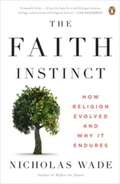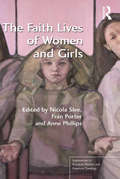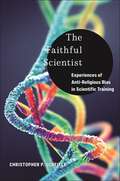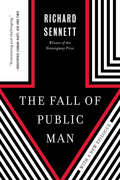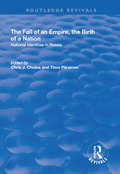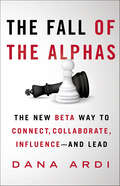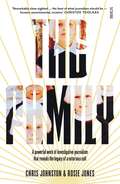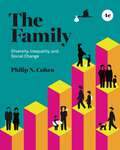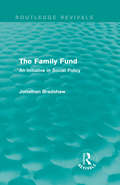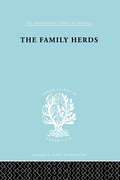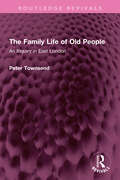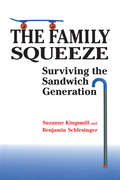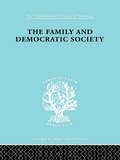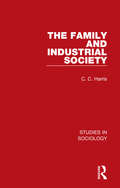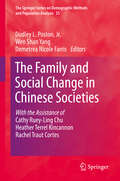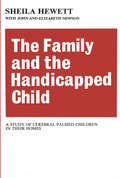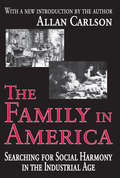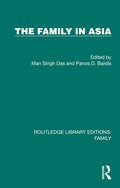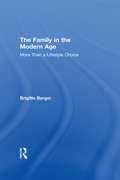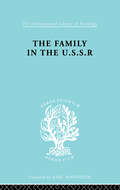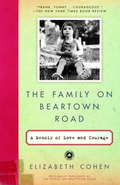- Table View
- List View
The Faith Instinct
by Nicholas WadeNoted science writer Nicholas Wade offers for the first time a convincing case based on a broad range of scientific evidence for the evolutionary basis of religion.
The Faith Instinct: How Religion Evolved and Why It Endures
by Nicholas WadeNoted science writer Nicholas Wade offers for the first time a convincing case based on a broad range of scientific evidence for the evolutionary basis of religion.
The Faith Lives of Women and Girls: Qualitative Research Perspectives (Explorations in Practical, Pastoral and Empirical Theology)
by Anne Phillips Nicola Slee Fran PorterIdentifying, illuminating and enhancing understanding of key aspects of women and girls' faith lives, The Faith Lives of Women and Girls represents a significant body of original qualitative research from practitioners and researchers across the UK. Contributors include new and upcoming researchers as well as more established feminist practical theologians. Chapters provide perspectives on different ages and stages of faith across the life cycle, from a range of different cultural and religious contexts. Diverse spiritual practices, beliefs and attachments are explored, including a variety of experiences of liminality in women’s faith lives. A range of approaches - ethnographic, oral history, action research, interview studies, case studies and documentary analysis - combine to offer a deeper understanding of women’s and girls' faith lives. As well as being of interest to researchers, this book presents resources to enhance ministry to and with women and girls in a variety of settings.
The Faithful Scientist: Experiences of Anti-Religious Bias in Scientific Training
by Christopher P. ScheitleReveals biases within scientific PhD training programs against emerging scientists who embrace a religious faith and the ramifications for scienceScience is often viewed as antithetical to religion, and it is true that scientists, particularly those who work at universities, are generally much less religious than the average American adult. So what is it like to be a religious individual pursuing an advanced education and career in science? Featuring engaging interviews and survey data from over 1,300 PhD students in the natural and social sciences, The Faithful Scientist shows that the core challenge is not contending with contradictions between faith-based beliefs and scientific knowledge. Instead, it is the bias budding scientific practitioners face from their colleagues if they are religious.These dynamics are important for science as a field, and ultimately for those who engage with or benefit from the results of scientific research. There are real benefits to fostering diversity in science, which may lead to more useful discoveries for populations who have generally not been the focus of research. And women, Black, and Latina/o people tend in general to be more religious than their white male peers, meaning that diversifying the gender, ethnic, and racial composition of the scientific workforce likely requires diversifying the religious composition too. This book offers vital empirical data that provide insight into what it means to support and foster religious diversity in science.
The Fall of Public Man (40th Anniversary Edition)
by Richard SennettA landmark study of urban society, reissued for the 40th anniversary of the original publication with a new epilogue by the author. A sweeping, farsighted study of the changing nature of public culture and urban society, The Fall of Public Man spans more than two centuries of Western sociopolitical evolution and investigates the causes of our declining involvement in political life. Richard Sennett’s insights into the danger of the cult of individualism remain thoroughly relevant to our world today. In a new epilogue, he extends his analysis to the new “public” realm of social media, questioning how public culture has fared since the digital revolution.
The Fall of a Great American City: New York and the Urban Crisis of Affluence
by Kevin BakerThe Fall of a Great American City is the story of what is happening today in New York City and in many other cities across America. It is about how the crisis of affluence is now driving out everything we love most about cities: small shops, decent restaurants, public space, street life, affordable apartments, responsive government, beauty, idiosyncrasy, each other. This is the story of how we came to lose so much—how the places we love most were turned over to land bankers, billionaires, the worst people in the world, and criminal landlords—and how we can - and must - begin to take them back. Co-published with Harper's Magazine, where an earlier version of this essay was originally published in 2018.As New York City approaches the third decade of the twenty-first century, it is in imminent danger of becoming something it has never been before: unremarkable. By unremarkable I don’t just mean periodic, slump-in-the-art-world, all-the-bands-suck, cinema-is-dead boring. I mean flatlining. No longer a significant cultural entity but a blank white screen of mere existence. I mean The-World’s-Largest-Gated-Community-with-a-few-cupcake-shops. For the first-time in our history, creative-youngpeople- will-no-longer want-to-come-here boring. Even, New-York-is-over boring. Or worse, New York is like everywhere else. Unremarkable. This is not some new phenomenon, but a cancer that’s been metastasizing on the city for decades now. Even worse, it’s not something that anyone wants, except the landlords, and not even all of them. What’s happening to New York now—what’s already happened to most of Manhattan, its core, and what is happening in every American city of means, Boston, Washington, San Francisco, Seattle, you name it—is something that almost nobody wants, but everybody gets. As such, the current urban crisis exemplifies our wider crisis: an America where we believe that we no longer have any ability to control the systems we live under.
The Fall of an Empire, the Birth of a Nation: National Identities in Russia
by CHRIS J. CHULOS and TIMO PIIRAINENThis title was first published in 2000: A collection of articles by Russian and Western experts on nationalism. The objective of the work is to give an overview of the new Russian identity-building and of the historical continuities that lie behind this ongoing process. The main theme is the shift from empire and imperial consciousness, characteristic both of the imperial Russia and the Soviet Union, towards a new identity as a nation state. Ultra-nationalism and the threat posed by ultra-right extremists groups is also among the most important themes in the book. The rising nationalist extremism is one of the several major projects that seek to redefine the Russion nationhood. The ultra-nationalist challenge is examined in several articles; the anatomy of extreme Russian nationalism is also examined through a case study of a small militant group of extremists.
The Fall of the Alphas: The New Beta Way to Connect, Collaborate, Influence—and Lead
by Dana ArdiThe new model for business success: replace top-down Alpha management with collaboration, connection, and increased job satisfaction—the Beta modelThe Fall of the Alphas explores the sweeping changes taking place in the corporate and social cultures of today's most successful organizations. Utilizing years of advising companies of all sizes, hypergrowth startups to Fortune 500 company management teams, Dana Ardi identifies a pivotal evolutionary moment: the decline of the traditional Alpha-model (the top-down, male-dominated, authoritarian, corner-office hierarchy that has ruled organizational landscapes for so long), as it is replaced by collaboration, connectivity, and the sharing of power. As Ardi persuasively demonstrates, in the new Beta organization, it is the team players, the sage advisors, the network experts, the trusted assistants, and the communications facilitators who are coming to the fore, as savvy managers learn to lead through influence and collaboration rather than authority and competition. From technology behemoths to small and medium-sized businesses, Beta has become the new paradigm for success in today's challenging market.With insight and practical guidance, Dana Ardi shows how any business organization or team can re-organize from Alpha to Beta—and be more effective, flexible, and profitable
The Familial Occult: Explorations at the Margins of Critical Autoethnography (EASA Series #47)
by Alexandra CoţofanăThe Familial Occult addresses the presence of occult experiences in some scholars' families and how that has affected their epistemological and ontological worlds, as well as their identities as scholars. Those with backgrounds in the familial occult often experience a series of conflicting relationships and different ways of interacting with binaries such as the subjective and objective, a powerful conceptual couple still governing academic thinking. While much has been written on encountering the occult in fieldwork or becoming an apprentice in an occult practice, little yet has been published in the academic literature about growing up with the occult.
The Family
by Chris Johnston Rosie JonesDrawing on revelatory new research, including interviews with survivors, The Family tells for the first time in full the strange and shocking story of one of the most bizarre cults in modern history.
The Family (Fourth Edition): Diversity, Inequality, And Social Change
by Philip N. CohenLearn the story—and the sociology—behind the data about today’s families Now the #1 book for the course, Philip Cohen’s The Family is an accessible, data-driven introduction to contemporary sociological thinking on families. Drawing on his expertise as a sociologist, demographer, and teacher, Cohen uses data to elucidate key trends in family life and to show how the story of today’s families is a story of diversity, inequality, and social change. A new Norton Illumine Ebook for the Fourth Edition brings this story to life through embedded Check Your Understanding questions with rich answer-specific feedback, Story Behind the Numbers animations, and new Dynamic Data Figures that help students develop their data literacy skills while learning about the biggest trends in family life. This purchase offers access to the digital ebook only.
The Family Fund: An Initiative in Social Policy (Routledge Revivals)
by Jonathan BradshawIn The Family Fund, first published in 1980, Bradshaw discusses the introduction of The Family Fund- a grant given to families in response of the discovery of the damages caused by the Thalidomide drug. He examines all aspects of the Fund including its origins, aims, publicity and its future. This text is ideal for students of sociology.
The Family Herds: A Study of Two Pastoral Tribes in East Africa, The Jie and T (International Library of Sociology #Vol. 128)
by P.H. GulliverFirst published in 1998. Routledge is an imprint of Taylor & Francis, an informa company.
The Family In Rural Society
by Raymond T Coward William M Smith Peter L Heller Louis A PlochSocial and political attention often is focused on urban issues, neglecting the still-rural character of much of the United States. This volume of original papers provides a clear picture of present-day rural society, with special emphasis on the changing role and structure of the family. It describes demographic trends, discusses the family aspects of the new wave of inmigrants to small towns and rural communities, reviews the diversity of patterns and forms adopted by rural families, considers the plight of the rural aged, and explores the dynamics of intrafamily personal relationships. The book ends with speculations on future prospects and challenges facing rural families.
The Family Life of Old People: An Inquiry in East London (Routledge Revivals)
by Peter TownsendFirst published in 1957, The Family Life of Old People opens with the question: Are old people isolated from their families? Thereafter, the author describes the results of intensive interviews with people of pensionable age in Bethnal Green in East London. Part one shows that most people are members of closely-knit extended families of three generations, often living in separate households in adjoining streets. The life of these families is of absorbing interest and the social structure of the home, the system of family care and the domestic, economic and social relationships between husbands and their wives, and between old people and their children and brothers and sisters, are carefully analysed. Part two discusses the social problems of old age against this background. This book will be of interest to students of sociology and gerontology.
The Family Squeeze
by Benjamin Schlesinger Suzanne KingsmillThe Sandwich Generation refers to the growing numbers of middle-aged people who must care for both children and elderly parents while trying to manage the stress of full-time jobs. Advances in technology and medicine are helping us to live longer - but not without extended care from our families. At the same time, the economic climate is making it difficult for young adults to leave home and start their own lives; they are often 'boomeranged' back to their parents for financial help, emotional support, and accommodation. In The Family Squeeze, Suzanne Kingsmill and Ben Schlesinger trace the day-to-day life of a typical family caught up in this situation. They guide the reader through various scenarios, paying particular attention to the 'woman in the middle,' who has traditionally been the caregiver to young and old but is now also a full-time member of the workforce. Each scenario is followed by comments, advice, and suggestions that will help the reader understand each stage of the game. The resource section includes an extensive annotated bibliography, as well as a list of selected services in Canada and the United States. Internet resources are also listed.Any person who is, or about to become, a member of the Sandwich Generation will find this a helpful guide for coping with the conflicting demands of family and work.
The Family and Democractic Society (International Library of Sociology)
by Joseph K. FolsomFirst published in 1998. Routledge is an imprint of Taylor & Francis, an informa company.
The Family and Industrial Society (Studies in Sociology)
by C. C. HarrisOriginally published in 1983, the origin of this book is to be found in C. C. Harris’s ‘Changing conceptions of the relation between family and societal form’ (in Scase: Industrial Society: Class, Cleavage and Control). In that article Harris attempted to relate traditional research on the family to recent developments in historical enquiry and Marxist scholarship. The aim of The Family and Industrial Society is to explain the character of the contemporary family by placing it in a wider historical and theoretical perspective. It is therefore directed at the undergraduate student for whom the ‘sociology of the family’, as a topic, has for too long been relatively unrelated to those contemporary developments in sociological thought and practice which inform other substantive areas of sociological work. The late C.C. Harris is perhaps best known for his best-selling introductory text The Family: An Introduction, first published in 1969. This new text was not, however, a straightforward replacement of an earlier book by a more up-to-date volume. Far too much had happened in sociology, in social studies and in family life itself, for a simple updating to make any sense. The Family was primarily a descriptive introduction, and was a presentation, albeit critical, of an orthodoxy. While this new book retains an introductory element based upon The Family’s earlier chapters, the greater part of it is exploratory and assumes a higher level of sophistication and sociological understanding; it is also substantially longer. Dr Harris was singularly well qualified to write a volume of this kind. Not only had he conducted and was conducting empirical research into the family, but his wide theoretical interests rendered him uniquely well placed to contribute to the theoretical development of his field. Few sociologists shared his familiarity with both anthropological and historical work. He was thoroughly familiar with the now unfashionable structural functional approach of which he had always been critical, but was enthusiastic about the potentialities of contemporary developments. The result is a sophisticated text which combines instruction, criticism, interpretation and exploration in one volume; which familiarises the student with the fundamental work of the past (too often neglected) and explores exciting new developments for the future. It also includes the only general discussion of change in the British family since the last edition of Fletcher’s The Family and Marriage in Britain.
The Family and Social Change in Chinese Societies
by Dudley L. Poston Wen Shan Yang Demetrea Nicole FarrisThis book focuses on families and their changes in Taiwan and China. Traditional notions of what constitutes a family have been changing in China, Taiwan and other Asian countries. The chapters in this book provide interesting methodological and substantive contributions to the discourse on family and social change in Chinese societies. They also underscore the implications of the various social changes in Chinese families. Written by Chinese and Western scholars, they provide an unprecedented overview of what is known about the effects of social change on Chinese families. One might think that defining a "family" is an easy task because the family is so significant to society and is universal. The family is the first place we learn culture, norms, values, and gender roles. Families exist in all societies throughout the world; but their constitution differs. In the past several decades there have been many changes in the family in Taiwan and China. For instance, whereas in the West, we use a bilineal system of descent in which descent is traced through both the mother's side and the father's side of the family, in many parts of China, descent is patrilineal, although this is changing, and China and Taiwan are starting to assume a family constitution similar to that in the West. This and other issues are discussed in great detail in this book. Indeed it is the very nature of the differences that motivated the writing of this book on changing families in Taiwan and China. The chapters in Part I: The Family in Taiwan and China focus on the basic family issues in Taiwan and China that provide the groundwork for many of the chapters that follow. Chapter 1 is about the distribution of resources in the family in Taiwan. Chapter 2 focuses on filial piety and the autonomous development of adolescents in the Taiwanese family, and Chapter 3 explores the important issue of family poverty in Taiwan. Chapter 4 moves away from Taiwan and looks at several issues of family growth and change in Hong Kong, noting the interesting similarities and differences between Hong Kong and China. Part II: Issues of Marriage, the Family and Fertility in Taiwan and China focuses specifically on marriage, family and fertility. In Chapter 5 the authors discuss the relationships between marital status, socioeconomic status and the subjective well-being among women in Hong Kong and Taiwan. Chapter 6 describes patterns of sexual activity in China and the United States. Chapter 7 considers gender imbalances in Taiwan and their impact on the marriage market. Chapter 8 also focuses on Taiwan and examines the effects of mothers' attitudes on daughters' interaction with their mothers-in-law. Chapter 9 compares female and male fertility trends and changes in Taiwan. Part III: Children and the Family in East Asia and in Western Countries consists of comparative studies of the family and children. Chapter 10 examines the dynamics of grandparents caring for children in China. Chapter 11 explores family values and parent-child interaction in Taiwan. Chapter 12 examines the significant amount of diversity among families in contemporary Taiwan. Chapter 13 describes adolescent development in Taiwan. Chapter 14 examines the impact of son preference on fertility in China, South Korea and the United States. And Chapter 15 explores the determinants of intergenerational support in Taiwan. The final chapter in our book, the only chapter in Part IV: The Family and the Future in Taiwan, examines the future of the family in Taiwan with respect especially to the marriage market and aged dependency.
The Family and the Handicapped Child: A Study of Cerebral Palsied Children in Their Homes
by Elizabeth NewsonThis book describes an inquiry into the upbringing of young cerebral palsied children. Following the precedent set by John and Elizabeth Newson in their studies of normal children at home; Sheila Hewett visited the mothers of 180 spastic children and obtained their personal accounts of their experiences.There is considerable literature on handicapped children in which the adverse effects of their presence in the family are emphasized. This study is the first to present, not evidence provided by professional people, but that of a large number of mothers of all social classes who have children with all degrees of handicap. They tell in their own words how they meet the problems and anxieties of everyday life and how they strive to maintain the norms of family living in spite of their very real difficulties. A measure of their success is provided by a number of comparisons with the families of normal children.Hewett's nursing experience combined with a social science training and personal experience of parenthood contributed a useful background for this research. Resulting as it does from close collaboration with the Newsons, her work provides an important extension of the main work of the Child Development Research Unit in Nottingham. It will help all those who work with handicapped children to achieve a better understanding of the families to whom they offer their specialist knowledge. To the general public it offers an opportunity to gain insights into a situation, which calls for their support and acceptance but not their pity. For the parents of handicapped children themselves it provides a much-needed opportunity to make their views known and to see that they are not alone in the difficulties, which they face with such stoicism and resourcefulness.This book's last aim has been achieved by using the now extensive information about the upbringing of normal children obtained from Nottingham mothers in the United Kingdom, by John and Elizabeth Newson.
The Family in America: Searching for Social Harmony in the Industrial Age
by Robert McC. AdamsThe Family in America offers a fresh interpretation of American social history, emphasizing the vital role of the family and household autonomy and threats to both imposed by industrial organization and the state. Allan Carlson shows that the United States, rather than being "born modern" as a progressive consumerist society, was in fact founded as an agrarian society composed of independent households rooted in land, lineage, and hierarchy.Carlson argues that family survival continues to be of paramount importance today. He critically examines five distinct strategies to restore a foundation for family life in industrial society, drawing on the insights of Frederic LePlay, Carle Zimmerman, and G. K. Chesterton. Carlson shows that family survival depends on the creation of meaningful, "pre-modern" household economies. This new edition includes an introduction by Allan Carlson, detailing the continued press of the industrial process onto the American family structure since initial publication of the book in 1993.
The Family in Asia (Routledge Library Editions: Family)
by Man Singh Das Panos D. BardisThe institution of the family is by far the most important of all the societal networks in which the lives of men, women and children are involved. Nowhere is this more true than in the less developed countries of Asia. Originally published in 1979, The Family in Asia aimed to provide a series of comprehensive survey chapters which described traditional family patterns in a selection of Asian countries at different stages of economic development. These range from a rapidly expanding and highly developed industrial nation, Japan, through modernising and developing countries, India, Pakistan, Iran, China, South Korea and the Philippines, to more underdeveloped countries, such as Thailand and Afghanistan. Each chapter is written by a senior country specialist and covers an integrated series of topics within a uniform framework in order to facilitate inter-country comparisons. Valuable description and statistical material is provided on the literature and on the effects of industrialisation, urbanisation and modernisation, but perhaps more important is a theoretical framework and the editors’ review of some basic characteristics of social modernisation. These include the degree of equalitarian family relations and sexual divisions in society; emphasis on individualism and independence; the differentiation and specialised functioning of social institutions; urban life; birth control and family planning; social mobility; marital disruption and divorce; neglect and care of the elderly; formal education for children; and government intervention and influence on family activities. Read in its historical context, this title will interest specialists in development and Asian studies, in demography, sociology and in anthropology. Students in particular, will value the tight analytical framework in which the book has been written.
The Family in the Modern Age: More Than a Lifestyle Choice
by Brigitte Berger"Many argue that the modern family is an anachronistic institution whose demise is only a question of time. Looking to the family's future, the eminent sociologist Brigitte Berger argues that despite being weakened and embattled, the family will survive as a fundamental social institution. The family has been the cradle of the modern social order for some three hundred years, and will remain the basis for any society concerned with happiness, liberty, equality, and prosperity for all its members. Rather than being condemned to the dust heap of history, or becoming a simple lifestyle choice, the modern family has a number of enduring strengths that will ensure its survival. In The Family in the Modern Age, Berger focuses on four major areas of concern. First, she demonstrates that the short shrift given to the institutional dimension of the family misrepresents the importance and the role of the family today. Second, she documents the close cognitive fit between core elements of the modern family and the stability of modern society, and argues that any society that ignores this connection does so at its own peril. Third, Berger investigates the degree to which currently identified problems may endanger the modern family's vital individual and social functions. And finally, she develops reasonable projections of the future of the family that will be core elements contributing to the creation of a politically democratic and economically prosperous world. Berger takes a long-range view of ""the career"" of the conventional family in the twentieth century. Her perspective is distinctly different from that widespread in scholarly literature today. She takes account of recent demographic shifts in behavior relating to sexuality, marriage, family structure and values, relationships, and family functions. Berger considers hotly contested contemporary issues relating to the family-gay marriage, divorce, abortion, women and work, issues of child-care, among others. Bu"
The Family in the USSR (International Library of Sociology)
by Rudolf SchlesingerFirst Published in 1998. Routledge is an imprint of Taylor & Francis, an informa company.
The Family on Beartown Road
by Elizabeth CohenANew York Times Notable Book The Family on Beartown Roadis Elizabeth Cohen’s true and moving portrait of love and courage. Elizabeth, a member of the “sandwich generation”—those caught in the middle, simultaneously caring for their children and for their aging parents—is the mother of baby Ava and the daughter of Daddy, and responsible for both. In this story full of everyday triumphs, first steps, and an elder’s confusion, Ava finds each new picture, each new word, each new song, something to learn greedily, joyfully. Daddy is a man in his twilight years, for whom time moves slowly and lessons are not learned but quietly, frustratingly forgotten. Elizabeth, a suddenly single mother with a career and a mortgage and a hamperful of laundry, finds her world spiraling out of control. Faced with mounting disasters, she chooses to confront life head-on, and to see the unique beauty in each and every moment. Imbued with an unquenchable spirit,The Family on Beartown Roadtakes us on a journey through the remarkable landscape that is family. From the Trade Paperback edition.
